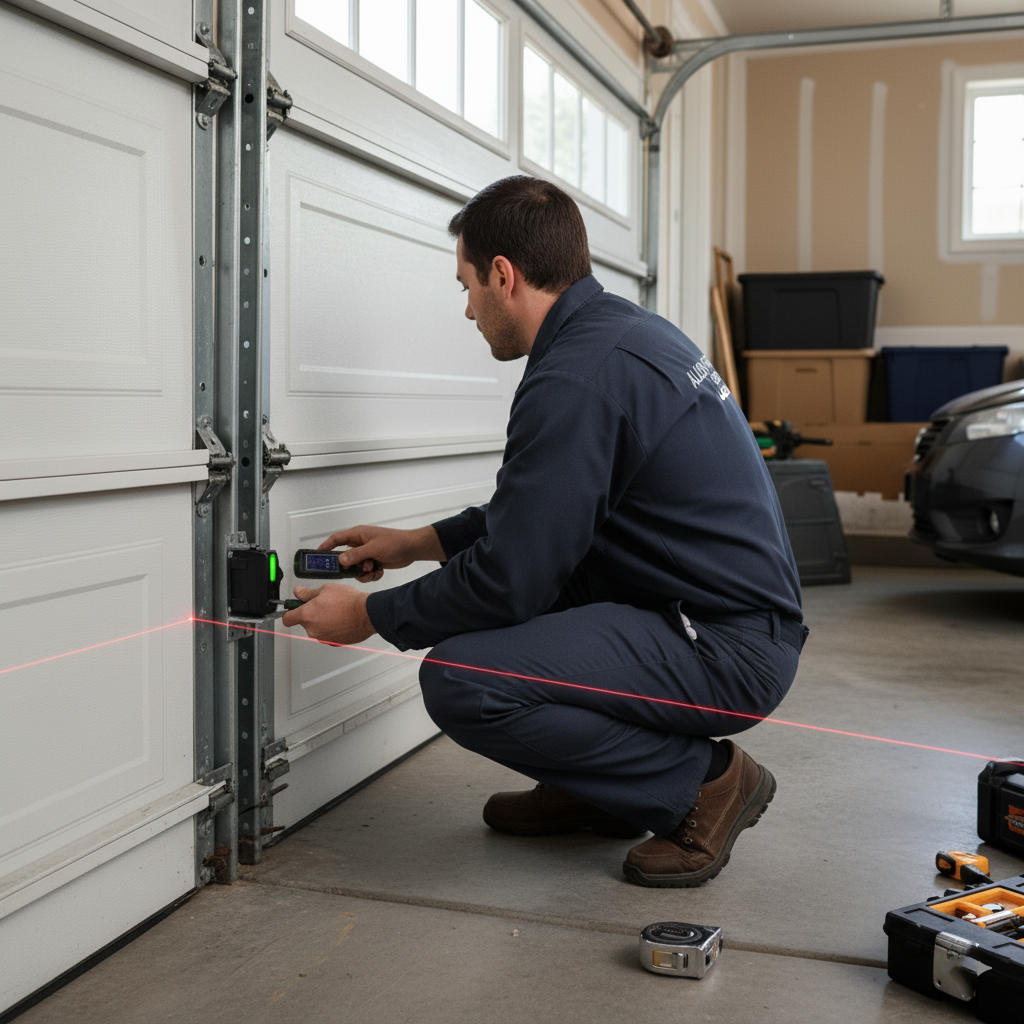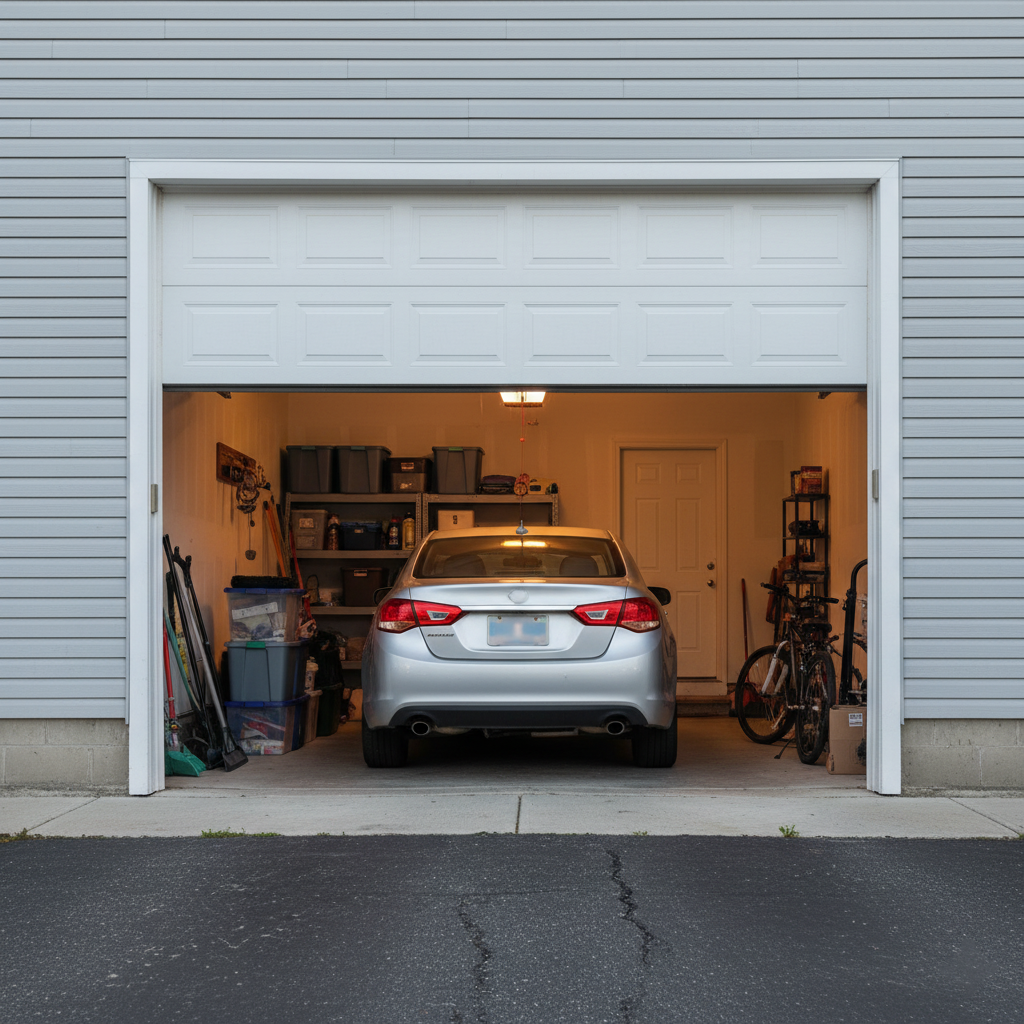Garage door sensors are essential safety features installed on modern garage doors. They prevent the door from closing if something or someone is in its path. Typically, they consist of two small devices positioned on either side of the door, near the floor. These sensors emit an invisible infrared beam, creating a “trip wire” that, when broken, signals the door to stop closing.
These sensors are not just a convenience; they are a critical component for preventing accidents and ensuring the safety of both people and pets. The technology behind these sensors has evolved, making them more reliable and sensitive to obstructions. However, despite these advancements, they are not immune to issues such as misalignment, which can compromise their functionality.
Misalignment can occur due to various reasons, such as accidental bumps, vibrations, or natural settling of the house. When sensors are not aligned, the garage door may refuse to close, causing inconvenience and potential safety hazards. It’s important to address these issues promptly to avoid any disruption in your daily routine and to maintain the security of your home.

Tools You’ll Need
Before you begin the alignment process, gather the following tools:
- A screwdriver
- A level
- A measuring tape
- A cleaning cloth
Having these tools ready will make the process smoother and more efficient. A screwdriver will help you adjust the mounting brackets, while a level ensures that the sensors are perfectly aligned. A measuring tape can be useful to verify the distance between the garage door sensors, ensuring they are equidistant from the ground. Finally, a cleaning cloth is essential for maintaining the clarity of the sensor lenses, which can be affected by dust and grime.
It’s also wise to have a flashlight on hand, especially if your garage is dimly lit. This will help you see the sensors clearly and ensure that all adjustments are made accurately. Keeping a small toolbox nearby can also be beneficial, allowing you to store any additional tools or parts you might need during the process.
Step-by-Step Guide to Aligning Garage Door Sensors

Step 1: Cut Power to the Garage Door
Safety first! Start by cutting power to your garage door opener. This step prevents any accidental activation during the alignment process. Locate the power cord connected to the opener and unplug it. If your system is hardwired, turn off the circuit breaker that powers the garage door. This precaution is crucial to avoid any electrical hazards or unexpected movements of the garage door while you work.
Taking this step also provides an opportunity to check the overall condition of the power supply and connections. Look for any signs of wear or damage that might indicate a need for further repairs. Remember, working with electricity always requires caution, so ensure that the power is completely off before proceeding.
Step 2: Clean the Sensors
Dirt and debris can obstruct the sensors’ function, so start by cleaning them. Use a soft cloth to gently wipe the lenses of each sensor. Ensure they are free from dust, cobwebs, or any residue that might interfere with the infrared beam. Regular cleaning not only helps maintain the sensors’ performance but also prolongs their lifespan.
In addition to cleaning the lenses, inspect the surrounding area for any potential sources of dirt or debris that could settle on the sensors over time. This includes checking for nearby plants, dusty tools, or any items stored in the garage that could contribute to grime buildup. Keeping the garage tidy can help prevent future obstructions and ensure the sensors remain clear.
Step 3: Inspect the Alignment
Next, visually inspect the sensors to assess their alignment. Each sensor should face directly towards its counterpart across the door. Use a level to ensure they are positioned at the same height on either side of the garage door. Misalignment, even by a small margin, can disrupt the infrared beam and cause the door to malfunction.
During this inspection, also check for any physical damage to the sensors or their brackets. Bent or cracked brackets can lead to misalignment and may need to be replaced. Ensuring that the sensors are securely mounted and not wobbling is crucial for accurate alignment and consistent performance.
Step 4: Adjust the Sensors
If the sensors are misaligned, you’ll need to adjust them. Loosen the screws holding each sensor in place using a screwdriver. Carefully move the sensor until it’s aligned with the opposite sensor. Use the level again to confirm they are perfectly horizontal. This adjustment is delicate work, so take your time to ensure precision.
While adjusting, make sure to maintain a gentle touch to avoid over-tightening or damaging the sensors. It’s also helpful to have a second person assist by holding the sensors in place while you adjust them, ensuring they remain steady and aligned during the process. This collaborative effort can make the task easier and more efficient.
Step 5: Secure the Sensors
Once aligned, secure the sensors in place by tightening the screws. Be cautious not to over-tighten, as this may damage the sensors or the mounting brackets. Properly secured sensors are less likely to shift out of alignment due to vibrations or minor impacts, ensuring long-term reliability.
After securing, double-check the alignment once more to confirm everything is in place. Consider applying a small amount of thread locker to the screws to prevent them from loosening over time. This added measure can contribute to the stability of the sensors, especially in garages with frequent use or vibrations.
Step 6: Test the Sensors
After securing the sensors, it’s time to test their alignment. Restore power to the garage door opener and try closing the door. If the door closes smoothly without reversing, your sensors are aligned correctly. Observing the door’s movement during this test can also highlight any other issues that might need attention.
If the door fails to close properly, recheck each step to ensure nothing was overlooked. It’s important to address any persistent problems as soon as possible to maintain the safety and functionality of your garage door system. Consistent testing and maintenance will help ensure the door operates reliably every time.

Troubleshooting Common Issues
Even after alignment, you may encounter some issues with your garage door sensors. Here are a few troubleshooting tips:
Door Still Won’t Close
If the door still won’t close, double-check the sensor alignment. Ensure there are no obstructions in the path of the infrared beam. Sometimes, even a small object can disrupt the signal. Additionally, check if the sensors are securely mounted, as loose sensors can cause intermittent issues.
If the problem persists, consider inspecting the garage door tracks and rollers. Misaligned tracks or damaged rollers can also affect the door’s movement and might be mistaken for sensor issues. Regular maintenance of these components can prevent such confusion and ensure smooth operation.
Intermittent Sensor Problems
If the sensor lights are off, it could indicate a power issue. Confirm that the garage door opener is plugged in and that the circuit breaker hasn’t tripped. Check for any blown fuses as well. Power issues can be a common cause of sensor malfunctions, and resolving them can often restore proper function.
In some cases, the sensors themselves may be faulty. Testing the sensors with a different power source or replacing them altogether might be necessary if all power supply issues have been ruled out. Consulting the manufacturer’s manual or customer support can provide additional guidance for these situations.
Preventative Measures
To maintain your garage door sensors in optimal condition, consider these preventative measures:
- Regularly clean the sensors to prevent dirt buildup.
- Periodically check the alignment and adjust as necessary.
- Inspect the wiring for signs of wear or damage.
- Avoid placing objects near the sensors that could block the beam.
In addition to these measures, consider scheduling regular professional maintenance for your entire garage door system. Professionals can perform detailed inspections and address potential issues that may not be immediately apparent. This proactive approach can save you time and money in the long run by preventing major repairs.
Educate everyone in your household about the importance of the sensors and how to avoid interfering with them. Simple awareness can prevent accidental bumps or misalignments, ensuring the sensors remain effective. Establishing a routine for checking and maintaining the sensors can lead to a longer lifespan and more reliable performance.
Customer Feedback from Google
Conclusion
Properly aligned garage door sensors are essential for the safe and efficient operation of your garage door. By following the steps outlined in this guide, you can ensure that your garage door sensors function correctly, providing peace of mind and convenience. Regular maintenance and prompt troubleshooting can save you time and prevent potential accidents. Remember, if you encounter persistent issues or feel unsure about the process, it’s always wise to consult a professional garage door repair technician for assistance.
Need help? Call us at 847-305-4535
With these tips and a bit of DIY spirit, you’ll keep your garage door running smoothly and safely for years to come. Taking the time to understand and care for your garage door sensors can enhance the overall security and efficiency of your home. By making these practices a part of your routine, you’ll not only preserve the functionality of your garage door but also enhance the safety of your household.
Dmytro Shevchenko is the owner and lead technician at Prime Garage Door Repair, located at 25975 N Diamond Lake Rd, Unit 111, Mundelein, IL 60060. Known for his honest service and expert craftsmanship, he ensures every garage door operates safely and smoothly for families and companies across the Chicago suburbs.
estimate






